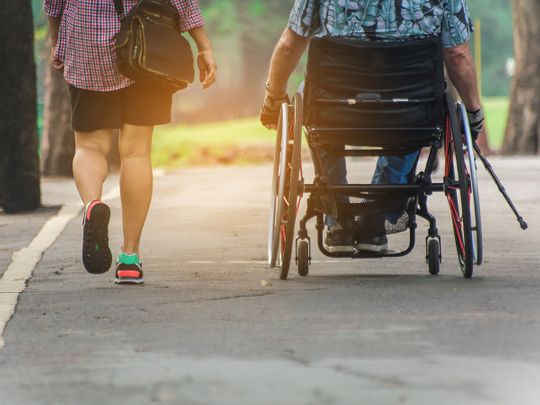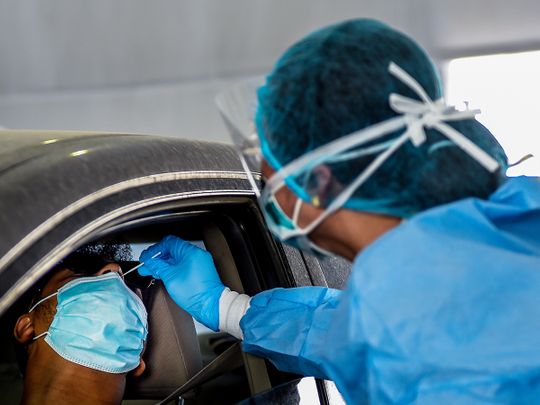My MS diagnosis freed me to finally love my body as it is

Image Credit: Shutterstock
I woke one morning soon after my 21st birthday to find my legs overcome with stiffness and pain. Overnight, walking became a burden, and my world would never be the same again.
For the next decade, doctors’ appointments consumed my every spare moment. Through graduate school, marriage and the birth of our two children, I poured my story out repeatedly but got no answers. Some doctors looked me in the eye and said I was exaggerating; others researched my case but gave up before finding an answer.
As my symptoms worsened in my 30s, I lost faith in my body and blamed it for letting me down, for stealing the best years of my life.
It took a long-delayed diagnosis of multiple sclerosis for my mind-set to change
This isn’t to say that my MS diagnosis at 34 was easy. Indeed, the vision of a future without disease had kept me going since age 21. Without a diagnosis, there’s still a chance this can all go away, I’d tell myself. So in 2017, when my doctor told me a test had revealed MS markers in my spinal fluid, I broke down. I feared the loss of a future rich with exploration, freedom and independence.
MS is an autoimmune disease that attacks the myelin, the protective covering surrounding nerves, resulting in a variety of symptoms, including weakness, loss of balance, pain, tingling and fatigue. Nearly a million people in the United States have MS, according to the National Multiple Sclerosis Society. The condition is three times more common among women than men and often begins between ages 20 and 50, during the prime of life.
When I first got sick at 21, an MRI revealed lesions on my brain – a common sign of MS – but a neurologist didn’t think I had the disease. “I don’t know what this is, but it’s not MS,” he told me. A repeat MRI six months later showed no change, and another years later was stable, too. Areas of demyelination in my brain were blamed on migraines.
My spinal fluid provided the data
Of the many doctors I saw, none ordered a lumbar puncture until I found the neurologist who diagnosed me. He said there were probably areas of demyelination too small to be seen on an MRI. My spinal fluid provided the data I’d been seeking for 13 years.
With my diagnosis came treatment. Over the coming weeks, months and years, my body adjusted to the immunosuppressant intravenous drug, Ocrevus, that I got by infusion every six months. The medication weakened my immune system, which had been attacking my myelin, but it also helped my physical abilities improve. Preparing dinner didn’t deplete my strength, and caring for my children became easier. Slowly, the fog from the emotional trauma lifted and the woman looking back at me in the mirror slowly began to resemble someone I recognized. For so long I’d resented my body. But maybe that wasn’t fair.
‘And without medication, I was barely able to stand’
For years I had answered the question, “Do you exercise?” with, “No. I’m not capable of exercise.” Yet there was nothing I wanted more than to go hiking with my husband, Josh, who had hiked the length of the Appalachian Trail. I wanted so badly to be a part of the activity he loves most in this world. But without a name for my disease, there was no treatment. And without medication, I was barely able to stand.
Now that I was getting treatment, I decided it was time to use this body I’d been dragging around for over a decade. I began training against low resistance on the exercise bike that had sat idle in my basement for years. Starting slowly, I set goals and pushed my body harder and harder. At times it felt as if I were pedaling through honey – I’d end early, feeling defeated. Other days I biked farther than I ever imagined my body could do.
Sixteen years after disease onset, with the ability to bike 15 miles against low resistance on most days, I felt human again. Slowly, I was able to add family trips to museums, short walks at the park and visits to my children’s school into my everyday life.
‘I released years of blame and fury’
This body of mine was not simply a vessel holding me down anymore. It was capable of venturing again into the world. I was far from perfect, but there was still much I could do. Maybe that was enough.
On our 12th anniversary – and three years into my treatment – my husband and I went to Asheville, N.C. On the second day of our trip, we parked at the foot of the Craggy Pinnacle Trail off the Blue Ridge Parkway, and I let my legs and all their baggage carry me forward, upward and through the trail of twisted rhododendron and lush, green moss. I pushed on, over boulders, past gnarled birch trees and through discomfort, climbing the 0.6-mile, 250-foot elevation gain rated “moderately difficult” by our guidebook.
At the peak, I collapsed and blurted out to the nearest stranger: “I just climbed my first trail in over a decade!” As I shouted my success from the mountaintop, I released years of blame and fury.
In that moment, for the first time in my adult life, I admired my body. I recognized how far I’d traveled through the darkest of years – how I’d awakened each morning knowing the day would be challenging but facing it anyway. Day after day. Year upon year.
I once felt the need to strive for perfection, but at the top of that mountain, my imperfect body showed me that it was more than enough. As the cool mountaintop air whistled by, I saw beauty in all I could do, instead of punishing myself for what I couldn’t.
Perhaps one day a new medication will allow my body to heal fully. But for now, I’ll take the imperfection, because it has made me appreciate every step I take.


